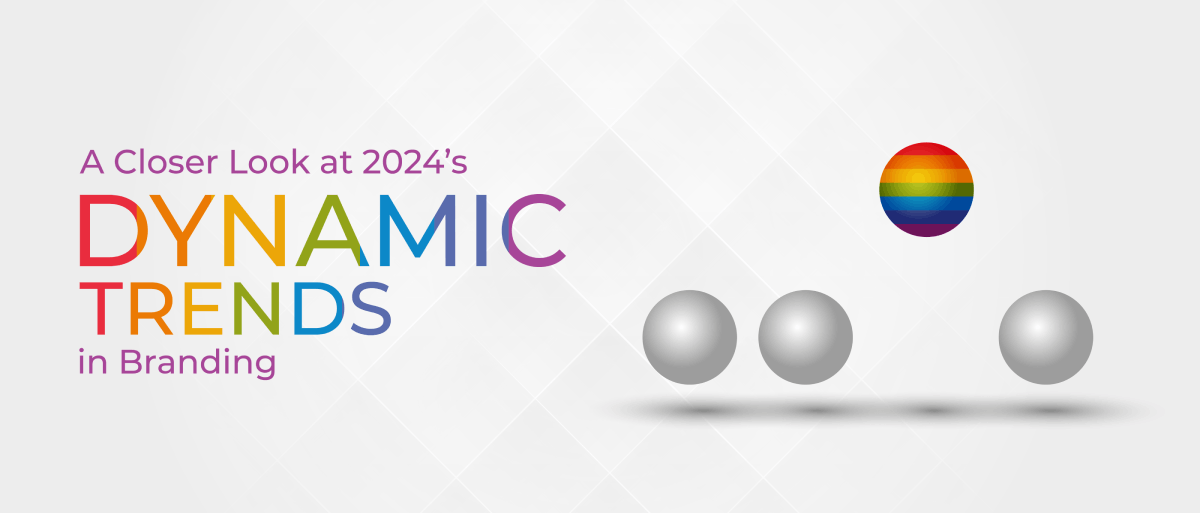
Branding is undergoing a profound transformation as we enter the futuristic landscape of 2024. A variety of factors are influencing how brands present themselves in the digital age, including consumer behaviour, technological advancements, and societal changes. In this blog, we explore the key branding trends for 2024, including human-centric branding and personalised branding.
Dynamic Brand Identities:
In 2024, static brand identities will be outdated. Consumers today are seeking dynamic and personal connections. Brands are using visual identities that are adaptable and flexible, so they may change to fit various situations and appeal to a range of audiences. This dynamism not only maintains the brand relevant and appealing but also allows for more versatile storytelling.
AI-driven Personalisation:
While personalisation has long been a branding buzzword, the use of artificial intelligence (AI) in 2024 elevates it to a new level. Large volumes of customer data are being analysed by brands using AI, and the results allow for hyper-personalised marketing tactics. AI is completely changing how marketers interact with people on a very personal level, from customised content to personalised product recommendations.
Rise of Virtual Influencers:
The landscape of influencer marketing is changing due to the emergence of virtual influencers. AI-powered virtual brand ambassadors are being developed by brands that can reflect the brand's values. These virtual personalities give brands a fresh approach to interact with consumers and keep a consistent brand image because of their perfect consistency and round-the-clock accessibility.
Human-Centric Branding:
The focus on human-centric branding is stronger than ever in 2024. The brands are realising how important it is to express their human side to establish genuine connections with their audience. This involves transparency, compassion, and a dedication to environmental and social causes. Beyond goods and services, human-centric branding highlights the common beliefs and experiences that unite a brand and its customers.
Sustainability & Ethical Branding:
Sustainability is now a central theme in branding rather than a niche concern. In response to consumers' growing awareness of their environmental impact, brands are implementing sustainable practices. By 2024, ethical branding will have evolved from greenwashing to a sincere dedication to social responsibility. Brands encourage a responsible and sustainable way of living in addition to selling products.
Augmented Reality in Branding:
The integration of augmented reality is redefining the consumers’ experiences. Brands are using augmented reality (AR) to let consumers virtually engage with things before they buy them. AR increases engagement and offers a more immersive brand experience, whether it is through letting users try on clothing, imagine furniture in their homes, or experience a product in a virtual environment.
Storyliving over Storytelling:
Storytelling has been a cornerstone of branding, but in 2024, brands are shifting towards Storyliving. This entails developing engaging brand experiences in which customers are invited to take part. Through gamified experiences, virtual reality installations, or interactive events, brands are including consumers in the story and creating a stronger emotional bond.
Blockchain for Brand Trust:
As worries about trust and data privacy increase, brands are looking to blockchain technology to establish legitimacy. Blockchain guarantees the legitimacy of items by ensuring transparency and traceability in the supply chain. Additionally, blockchain is being used to validate information, stopping false information from spreading and boosting consumer confidence in brands.
Niche and subcultural branding:
Subcultural and niche branding—which target specific consumer groups—are becoming more popular to keep up with the "locality" trend. This is not a generic story; rather, it is an offer and planning of a customised experience tailored specifically to the needs of each group. This will stimulate the creation of novel experiences and foster the growth of branding innovation.
Revival of retro branding:
Businesses are increasingly recreating the aesthetics of bygone eras and fusing them with modernity to produce a blend of novelty and recognition. Retro branding is making a comeback owing to mix of familiar elements that heighten nostalgia and transport consumers back to more carefree days while still having value and resonance in today's marketplace. Furthermore, because it is something native and "painfully" familiar, the customer responds instantly.
At last,
The future of branding in 2024 will be dynamic, individualised, and human- centred as we negotiate its always changing terrain. Adopting these branding trends in 2024 can help brands stay current and build enduring relationships with their target market. A dedication to sustainability, the emergence of virtual influencers, and the integration of AI for hyper-personalisation are just a few examples of how the branding environment is changing to meet the demands of consumers. It is obvious that going forward, businesses that are successful will be those who comprehend, adjust, and genuinely connect with the varied and changing needs of their target market.